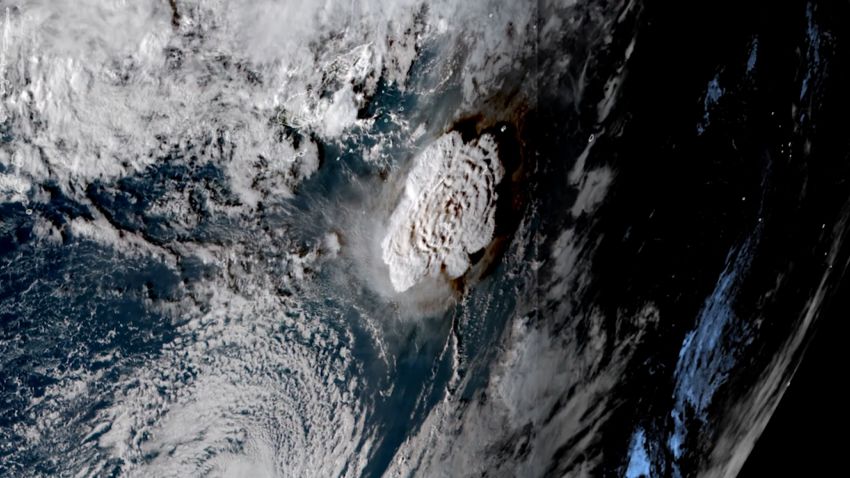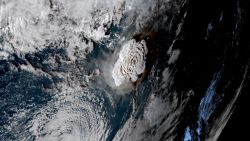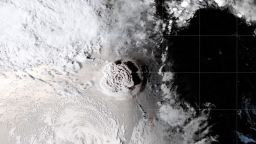Sign up for CNN’s Wonder Theory science newsletter. Explore the universe with news on fascinating discoveries, scientific advancements and more.
One of the most powerful volcanic eruptions on the planet blasted such a massive amount of water vapor high into the atmosphere that it’s likely to temporarily warm the Earth’s surface, according to detections from a NASA satellite.
When the undersea Hunga Tonga-Hunga Ha’apai volcano erupted on January 15, 40 miles (65 kilometers) north of Tonga’s capital, it created a tsunami as well as a sonic boom that rippled around the world – twice.
The eruption sent a tall plume of water vapor into the stratosphere, which is located between 8 and 33 miles (12 and 53 kilometers) above the Earth’s surface. It was enough water to fill 58,000 Olympic-sized swimming pools, according to detections from a NASA satellite.
The detection was made by the Microwave Limb Sounder instrument on NASA’s Aura satellite. The satellite measures water vapor, ozone and other atmospheric gases. After the eruption occurred, the scientists were surprised by the water vapor readings.
They estimate that the eruption delivered 146 teragrams of water to the stratosphere. One teragram is the equivalent of a trillion grams, and in this case, it was equal to 10% of the water already present in the stratosphere.
That’s nearly four times the amount of water vapor that reached the stratosphere after the 1991 Mount Pinatubo eruption in the Philippines.
A new study about the water vapor findings published in July in Geophysical Research Letters.
“We’ve never seen anything like it,” said study author Luis Millán, an atmospheric scientist at NASA’s Jet Propulsion Laboratory in Southern California, in a statement. “We had to carefully inspect all the measurements in the plume to make sure they were trustworthy.”
Keeping an eye on Earth
The Microwave Limb Sounder instrument can measure natural signals of microwaves from Earth’s atmosphere and detect them even through thick ash clouds.
“MLS was the only instrument with dense enough coverage to capture the water vapor plume as it happened, and the only one that wasn’t affected by the ash that the volcano released,” Millán said.
The Aura satellite launched in 2004 and since then it has only measured two volcanic eruptions that lofted substantial water vapor so high up in the atmosphere. But the water vapor from the 2008 Kasatochi event in Alaska and the 2015 Calbuco eruption in Chile dissipated rather quickly.
Typically, powerful volcanic eruptions like Mount Pinatubo or the 1883 Krakatoa event in Indonesia cool Earth’s surface temperature because the gas, dust and ash they spew reflects sunlight into space. This “volcanic winter” happened after the Mount Tambora eruption in 1815, triggering “the year without a summer” in 1816.
The Tonga eruption was different because the water vapor it sent into the atmosphere can trap heat, which could cause warmer surface temperatures. The excess water vapor could stay in the stratosphere for several years, according to the researchers.
The additional water vapor in the stratosphere could also lead to chemical reactions that temporarily contribute to the depletion of Earth’s protective ozone.
Anatomy of an eruption
Fortunately, the warming effect of the water vapor is expected to be small and temporary, and will dissipate as the extra vapor diminishes. The researchers don’t believe it will be enough to exacerbate existing conditions due to the climate crisis.
The researchers believe the main reason for the amount of lofted water vapor was due to the depth of the volcano’s caldera 490 feet (150 meters) below the ocean’s surface.
If it was too deep, the depth of the ocean would have muted the eruption, and it was too shallow, the amount of seawater heated by the erupting magma wouldn’t have matched what reached the stratosphere, the researchers said.
Scientists are still working to understand the unusually energetic eruption and all of its superlatives, including hurricane-strength winds that reached space.






















